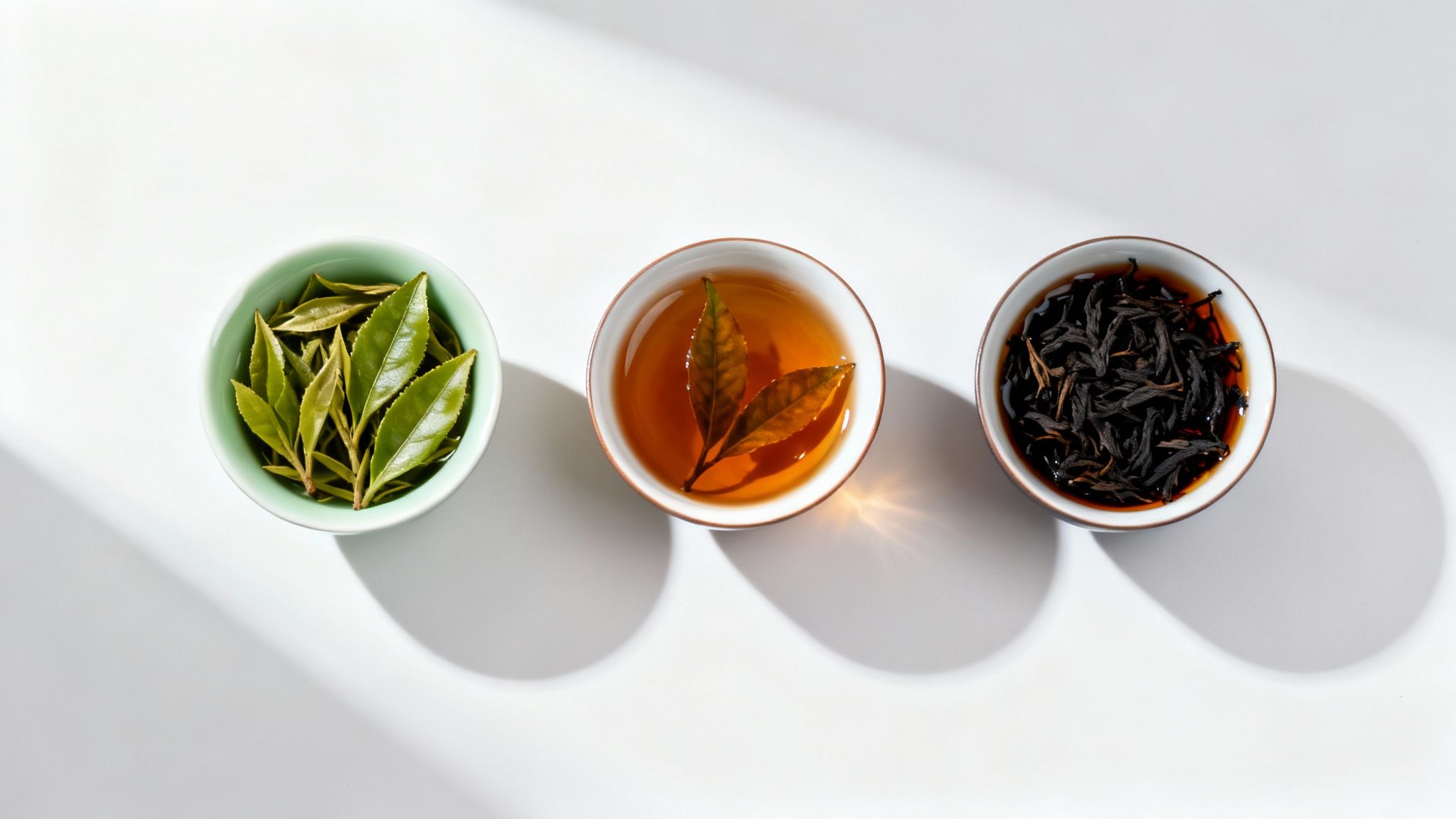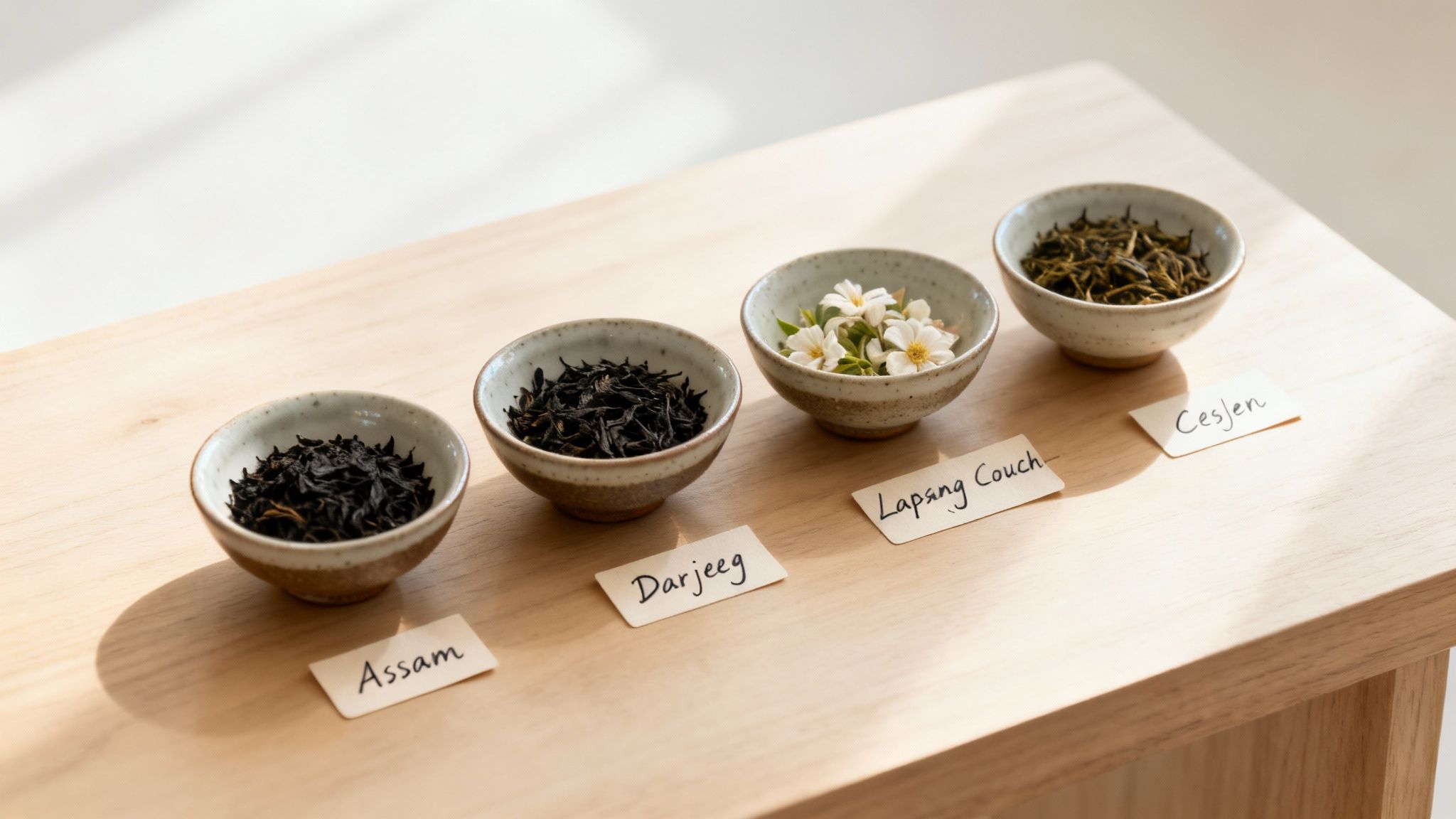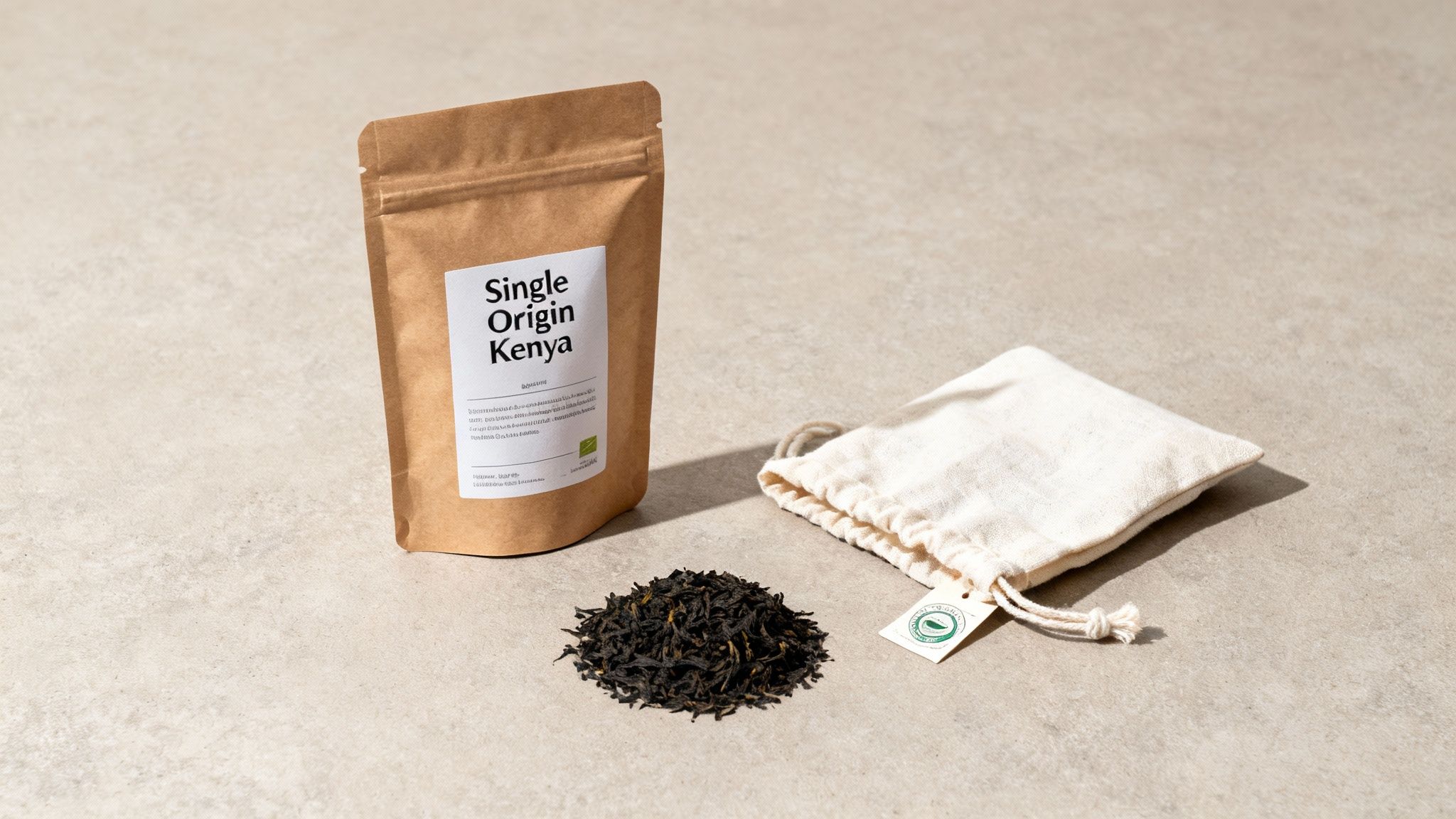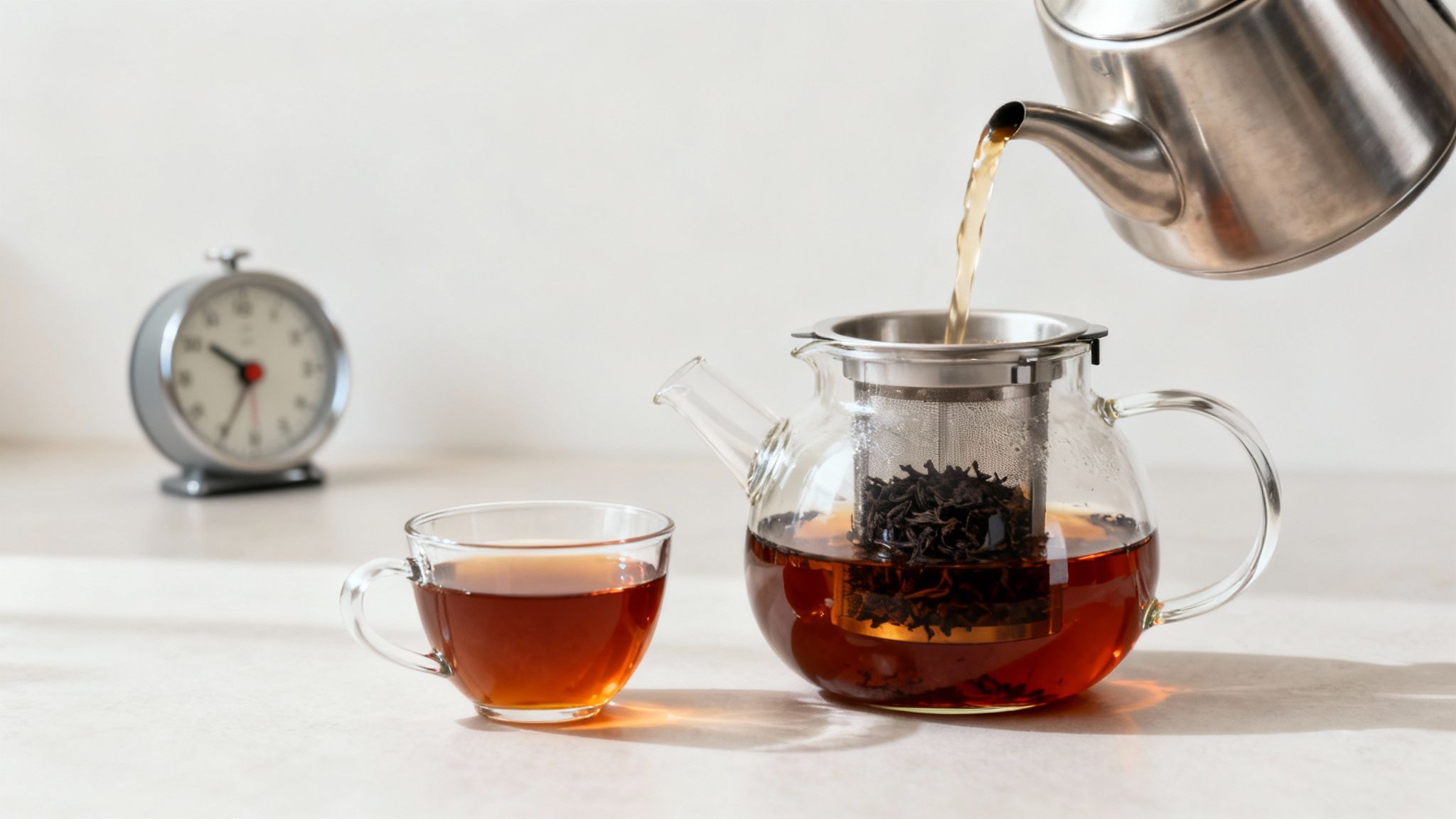Step into the world of black tea, and you’ll find a spectrum of flavours that's as rich and varied as a vineyard's finest offerings. From the bold, malty punch of an Assam to the light, floral notes of a Darjeeling, the sheer diversity can be astonishing.
So, what’s the secret? It all comes down to where the Camellia sinensis plant is grown and, crucially, how its leaves are treated after being picked. The key step is a process called oxidation, which unlocks the deep colours and complex character that make black tea so beloved.
Understanding the World of Black Tea

Before we dive into the different regions and names, let's get to the heart of what makes a black tea black. While all true teas—green, white, oolong, and black—come from the very same plant, the magic happens in the processing. The defining moment for black tea is oxidation.
Think of what happens when you slice an apple and leave it on the counter. The flesh slowly turns brown and its flavour deepens. That's oxidation at work. For tea makers, this isn't an accident; it's a carefully controlled art form. This exposure to oxygen is what transforms the fresh green leaves into the deep, dark colours we recognise and develops those wonderfully robust, full-bodied flavours.
A Diverse Spectrum of Flavours
This one step opens up a whole universe of taste and aroma. Get ready to explore an incredible range of profiles:
- Robust and Malty: Teas like Assam from India pack a strong, invigorating punch. They’re the classic breakfast brew, and for good reason—they hold up beautifully to a splash of milk.
- Fragrant and Floral: At the other end of the scale is Darjeeling, often called the "champagne of teas." It’s celebrated for its delicate, fruity notes of muscatel grape.
- Crisp and Citrusy: Hailing from Sri Lanka, Ceylon teas offer a bright, brisk finish that’s perfect for lifting your spirits in the afternoon.
- Smoky and Unique: Then there's Lapsang Souchong, a tea with a personality all its own. The leaves are dried over pinewood fires, giving them a distinctively smoky character you won't forget.
This journey through black tea shows how place, climate, and craft all come together to create a unique personality in every single cup. Getting to know these factors is the best way to find a brew you'll truly love.
To give you a head start, the table below is a quick-glance guide to the major players we'll be exploring. Think of it as your map for the tasting journey ahead, summarising the essentials of each one. If you’re curious about the bigger picture and how black tea fits in with other brews, our guide to the main types of tea is a great place to start.
Quick Guide to Major Black Tea Varieties
This table offers a snapshot of the world's most popular black teas, covering their origin, signature flavours, and brewing tips to get the best out of every cup.
| Tea Variety | Origin | Flavour Profile | Best Brewed |
|---|---|---|---|
| Assam | India | Strong, malty, full-bodied, brisk | 3-5 minutes |
| Darjeeling | India | Floral, fruity, muscatel grape notes, light | 2-3 minutes |
| Ceylon | Sri Lanka | Crisp, citrusy, bold, bright | 3-4 minutes |
| Keemun | China | Fruity, wine-like, hint of smoke, mellow | 2-3 minutes |
| Lapsang Souchong | China | Intensely smoky, pine resin, rich | 3-5 minutes |
Now that you have your bearings, let's take a closer look at what makes each of these exceptional teas tick.
How Black Tea Became a British Staple
Though black tea was born in China, its journey into the heart of British culture is a fascinating tale of empire, trade, and a seismic shift in global power. In the early 19th century, tea was still an exotic luxury, and Britain was almost entirely reliant on China for its supply. This created a huge trade imbalance that London was desperate to fix.
The solution was audacious and would change the world of tea forever. Instead of buying from China, the British Empire decided it would build its own tea industry from scratch. This wasn't just a case of planting a few seeds; it was a massive undertaking of botany, industry, and politics, all centred on the fertile lands of British-controlled India and Ceylon (now Sri Lanka).
This strategic move was about more than just ensuring a steady supply. It was about controlling the entire chain, from leaf to cup, and crafting a product perfectly suited to British tastes.
The Rise of Empire Tea
The pivot away from Chinese teas was a direct answer to tricky logistics and politics. China's insular policies and reliance on small-scale farms made it tough for the British to get the sheer volume of tea needed to quench a growing national thirst. Finding a new source shot to the top of the priority list.
By the mid-19th century, British-led efforts in India started to pay off. Plantations sprung up in regions like Assam, where a native variety of the Camellia sinensis plant was discovered. This version was robust and malty, a perfect match for the British palate, which favoured a strong, brisk brew—often taken with milk and sugar.
The change was incredibly fast and decisive. You can see it in the historical data; the UK market completely transformed, driven by these new imperial plantations. By 1900, China's once-mighty share of the British tea market had collapsed to just 10%. Teas from India and Ceylon now dominated the scene.
Crafting a National Flavour
The new black tea varieties from India and Ceylon weren't just stand-ins; they were a better fit for what British drinkers wanted. Assam, with its full-bodied, brisk character, became the foundation of the classic "English Breakfast" blend. Meanwhile, Ceylon tea from the highlands of Sri Lanka offered a crisp, citrusy alternative that was bright and wonderfully refreshing.
These teas were deliberately grown and processed to create a darker, stronger liquor that wouldn't be overwhelmed by a splash of milk.
The bold flavour profile we now think of as quintessentially "British" is a direct legacy of this colonial project. It was shaped not just by taste, but by the commercial and political ambitions of an empire chasing self-sufficiency.
This era also saw tea cementing its place in the daily routine, most famously with the ritual of afternoon tea. What started as a high-society trend soon blossomed into a beloved institution across the country, turning a simple drink into a cultural cornerstone.
The Enduring Legacy of a Cuppa
Today, the strong, bold character of these black teas is still the benchmark for a proper British cuppa. While our tastes are broadening, the national preference for a robust brew is a direct echo of that 19th-century commercial revolution.
The story of how black tea became a British staple is a lesson in how history, economics, and culture can brew together to shape something as simple as our daily drink. It explains why a tea grown in the hills of Assam or Sri Lanka can feel so fundamentally British. For a deeper look at how this daily ritual came to be, the history of Afternoon Tea: From Girl Dinner to a British Institution is a fascinating read.
A Global Tour of Iconic Black Teas

To really get to grips with the huge variety of black teas, you have to go to the source. The unique personality of every tea comes down to its terroir—a lovely term borrowed from the wine world that covers everything about its environment, from the soil and climate to the altitude. Let’s head off on a journey through the world's most famous tea regions to see what makes each cup so special.
Our tour kicks off in India, a true giant in the tea world and home to two of the most famous black teas you can find. And honestly, they couldn't be more different.
Assam: The Bold Foundation of Breakfast Blends
Deep in the lush, low-lying plains of Northeast India, you’ll find Assam, the largest single tea-growing region on the planet. The environment here is a tea plant’s dream: rich loamy soil, sky-high humidity, and plenty of rain. It's the perfect tropical greenhouse for the native Camellia sinensis var. assamica plant, which grows big, hearty leaves perfect for a strong, full-bodied brew.
Assam is the undisputed king of breakfast teas. Its flavour is powerful and malty, a rich and straightforward character that holds its own beautifully against a splash of milk and a spoonful of sugar.
When brewed, Assam gives you a dark, reddish-brown liquor with a brisk, invigorating finish. It’s the one you reach for when you need a proper wake-up call. That strength is no accident; it’s a direct result of its terroir, which pushes the leaves to produce all the compounds that create its signature bold taste.
Darjeeling: The Champagne of Teas
Leaving the plains of Assam behind, we climb high into the misty foothills of the Himalayas to find Darjeeling. Here, tea gardens cling to steep slopes, sometimes at altitudes of over 2,000 metres. The cool mountain air and rocky soil mean the tea plants grow slowly, which concentrates all the aromatic oils in the leaves for an incredibly delicate and complex flavour.
Unlike the powerful punch of Assam, Darjeeling is celebrated for its light, floral, and fruity notes, often with a distinct muscatel grape-like sweetness. It brews a much lighter, golden-amber liquor, and its nuanced character is definitely one to be enjoyed on its own, without milk.
Darjeeling's flavour changes dramatically with each harvest, or "flush." The First Flush, picked in early spring, is highly prized for its vibrant, floral character, while the Second Flush offers a more rounded, fruity profile.
It’s this remarkable subtlety that has earned Darjeeling its prestigious title, "the champagne of teas." Every sip tells a story of its high-altitude home. If you want to experience this exceptional tea, starting with a quality Darjeeling First Flush is a fantastic way to appreciate just how unique it is.
Ceylon: The Bright and Brisk Island Brew
Next, we head south to the island nation of Sri Lanka, which you might know by its former name, Ceylon. Tea grows all over the country, from the lowlands right up to the central mountains. This variation in altitude creates a fantastic range of black teas, but the classic Ceylon flavour really shines in the high-grown teas from regions like Nuwara Eliya and Dimbula.
Ceylon black tea is famous for its bright, crisp, and clean taste. It often carries lovely hints of citrus and spice, delivering a brisk and refreshing finish that makes it the perfect afternoon pick-me-up.
Its lively character and medium body also make it incredibly versatile. It’s wonderful served hot with a slice of lemon, but it also makes a brilliant iced tea because its flavours stay clear and vibrant even when chilled.
Lapsang Souchong: The Smoky Enigma from China
Our journey now takes us to the Wuyi Mountains in China's Fujian province, the historical birthplace of black tea. It's here we find one of the most distinctive teas out there: Lapsang Souchong. Its unique flavour isn't just about terroir; it's the result of a very specific, time-honoured process.
After the leaves have oxidised, they are traditionally smoke-dried over pinewood fires. This step infuses the tea with a powerful, smoky aroma and flavour that people often compare to pine resin, woodsmoke, or even a good whisky.
This is a tea that demands your attention. The flavour is intense and savoury, a world away from the malty or floral notes of other black teas. While its bold profile might not be for everyone, Lapsang Souchong is a truly memorable experience for the adventurous tea drinker.
Keemun: The Mellow and Fruity Burgundy of Tea
Also from China, but this time from Anhui province, Keemun is another celebrated black tea with a much softer personality. Often called the "Burgundy of tea," it’s loved for its mellow character and wonderfully complex aroma.
Unlike the smoky intensity of Lapsang Souchong, Keemun offers subtle notes of stone fruit, a wine-like quality, and sometimes even a hint of unsweetened cocoa. It has a gentle, smooth finish with very little bitterness, making it an approachable yet sophisticated choice.
Its unique aroma, sometimes described as being like an orchid, is the hallmark of a high-quality Keemun. This tea beautifully showcases the more delicate and nuanced side of Chinese black teas, proving that boldness isn't the only measure of a great brew.
From the robust plains of Assam to the smoky mountains of Wuyi, each of these iconic black teas tells the story of where it came from. Understanding their unique terroir and processing is the key to appreciating the incredible diversity hiding in your teacup.
Exploring Modern Black Tea Trends

While the rituals of brewing black tea feel timeless, the industry itself is always moving. Right now, a wave of fresh thinking is changing everything from where our tea is grown to how we fancy brewing it at home. It’s all being driven by a new generation of tea drinkers who are more curious, conscious, and connected than ever.
This isn't just about flavour anymore. People want to know the story behind their cuppa. This desire for transparency is sending ripples right through the supply chain, and it’s fascinating to watch.
A New Map for Sourcing Black Tea
For centuries, the story of Britain's tea was tied to the plantations of India and Sri Lanka. But if you look at the sourcing map today, it tells a very different tale. East African countries, especially Kenya, have become absolute powerhouses in the global black tea market, now serving as a primary supplier for the UK.
Why the change? It's about flavour and function. Kenyan teas are celebrated for their bright, bold, and incredibly consistent character. This makes them the perfect base for the strong blends that fill the tea bags lining our supermarket shelves. For the big brands, that reliability is everything.
It’s a great reminder that the cup of tea on our desk is still shaped by global trade, with new chapters in its long history being written all the time.
The Rise of Conscious Consumerism
Today’s tea drinker is asking questions. Where did this come from? Who grew it? Was it produced fairly and with respect for the planet? This growing hunger for ethical and sustainable tea is one of the biggest shifts happening right now.
As a result, certifications have become a crucial shorthand for responsibility. When you spot these labels on a box, they're signalling a commitment to a better way of doing things:
- Rainforest Alliance: This little green frog is all about environmental conservation. It certifies that tea is grown in a way that protects forests, conserves water, and supports biodiversity, while also looking out for the well-being of farm workers.
- Fairtrade: The Fairtrade mark is a guarantee that farmers have been paid a fair price for their tea. It's a simple but powerful way to help create more stable livelihoods for small-scale growers and their communities.
These aren't just logos; they're a promise. They give us the power to make choices that line up with our values, turning a simple purchase into a vote for a fairer, more sustainable tea world.
The UK market is a perfect example of this in action. Black tea still accounts for about 90% of all tea we drink, but our tastes are changing. We're leaning towards higher-quality, ethically sourced brews, and the major players are taking note by putting these certifications front and centre. You can learn more about how UK tea market trends and ethical sourcing are influencing the industry.
From Tea Bags to Loose-Leaf Exploration
Maybe the most exciting trend of all is the move away from the humble tea bag and back towards the ritual of loose-leaf tea. This isn't just about being a traditionalist; it’s a search for better flavour, aroma, and quality.
Loose-leaf teas are made from whole or large, broken leaves, which means they hold onto far more of their natural essential oils. The result is a brew with a depth and complexity that the fine "dust" in most paper tea bags just can't match.
For many, brewing loose-leaf has become a welcome pause in a busy day—a mindful moment to slow down and properly connect with what you’re drinking. It throws open the door to a whole world of new black tea varieties, from single-origin gems to creative artisanal blends you’ll never find in a standard bag. It just goes to show that for more and more of us, tea isn't just a drink. It's an experience to be savoured.
How to Brew the Perfect Cup

Knowing the story behind a tea is one thing, but bringing its flavour to life? That’s all in the brew. Moving beyond simply dunking a tea bag is the secret to a consistently brilliant cup, and it’s not about rigid rules. It’s about understanding a couple of key ideas that can transform your daily ritual.
The two things that matter most are water temperature and steeping time. For most black teas, you’ll want your water just off the boil, around 95-100°C. That heat is crucial for coaxing out all the deep, complex flavours from the fully oxidised leaves. Much like with coffee, getting the optimal water temperature for brewing makes all the difference.
Steeping time, on the other hand, is where you get to play. A shorter brew keeps things light and zesty, while a longer one will give you a much bolder, more robust cup. There’s no single “right” answer—it all comes down to what you fancy.
Mastering the Basics
Think of these as a starting point. Your goal is a perfect balance between strength and smoothness, and from here, you can tweak things to find what you love.
- For robust teas (like Assam or English Breakfast): Use that boiling water and let it steep for 3-5 minutes. This is what draws out their signature malty depth.
- For delicate teas (like a Darjeeling First Flush): Go for slightly cooler water, around 85-90°C, and a shorter steep of 2-3 minutes. This protects those fragile floral notes from getting scorched.
The perfect cup is a personal discovery. Start with these recommendations, but don't be afraid to experiment. Shave 30 seconds off the steep time, or add another minute, just to see what happens. You're in charge here.
Loose-Leaf Versus Tea Bags
Now, the choice between loose-leaf and tea bags really does make a difference. Bags are handy, no doubt. But for a truly superior flavour experience, loose-leaf is the way to go.
The whole, unbroken leaves have so much more surface area to unfurl, mingle with the water, and release their aromatic oils. The result is a cup with far more nuance and character. If you’re ready to take the plunge, this simple guide on how to brew loose leaf tea is a great place to start.
And the age-old British debate over milk? Whether you add it first or last is a matter of fierce opinion, but there's a practical side to it. Adding milk last lets you properly judge the tea's strength first. But really, the best way is whatever way you enjoy it most.
Your Black Tea Questions, Answered
As you venture deeper into the world of black tea, it’s only natural for a few questions to pop up. Let's tackle some of the most common ones, from caffeine content to what makes it different from its green cousin.
What's The Real Difference Between Black and Green Tea?
It all boils down to one simple, yet transformative, step: oxidation. Once picked, the leaves destined to become black tea are allowed to fully oxidise. This process turns them their characteristic dark colour and develops those rich, malty flavours we love.
Green tea, on the other hand, is heated almost immediately to stop oxidation in its tracks. This locks in the leaves' fresh green colour and creates a much lighter, more vegetal taste. It's a bit like the difference between a crisp, fresh apple and one that's been slow-baked into a sweet, caramelised treat.
Does Black Tea Have More Caffeine Than Coffee?
Not usually, no. Your average 237ml (8oz) cup of black tea contains around 40-70mg of caffeine. A coffee of the same size packs a much bigger punch, typically landing somewhere between 95-165mg.
So, as a rule of thumb, black tea has about half the caffeine of coffee. Keep in mind that the exact amount will always vary a little depending on the type of tea, your water temperature, and how long you brew it for.
How Should I Store Black Tea to Keep It Fresh?
Good storage is absolutely crucial for protecting your tea's gorgeous flavour and aroma. The best way is to keep it in an airtight container, stashed away in a cool, dark place like a pantry or cupboard.
You want to keep it well away from direct sunlight, moisture, and any strong smells from spices or other foods. Stored properly, your loose-leaf black tea will stay fresh and full of character for up to two years.
What Does The Term 'Terroir' Mean When We Talk About Tea?
Terroir is a wonderful term, borrowed from the world of wine, that perfectly captures the entire natural environment in which a tea is grown. It's everything from the soil and the local climate to the specific altitude of the tea gardens.
The unique terroir of a region like Darjeeling or Assam is precisely what gives the tea its unmistakable character—a signature flavour that simply can't be copied anywhere else on earth.
At Jeeves & Jericho, we believe that knowing the story behind your tea makes every sip that much better. Why not explore our collection of exceptional whole leaf teas and find your new favourite today?


